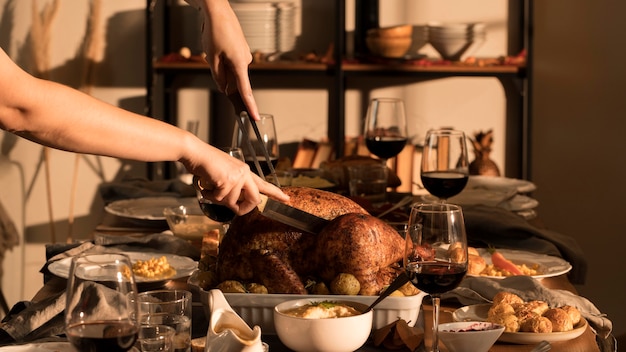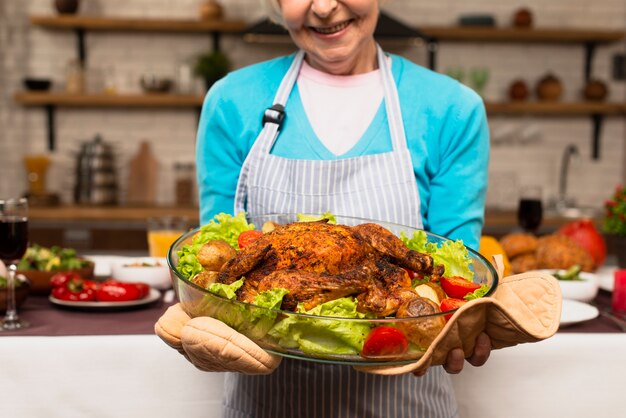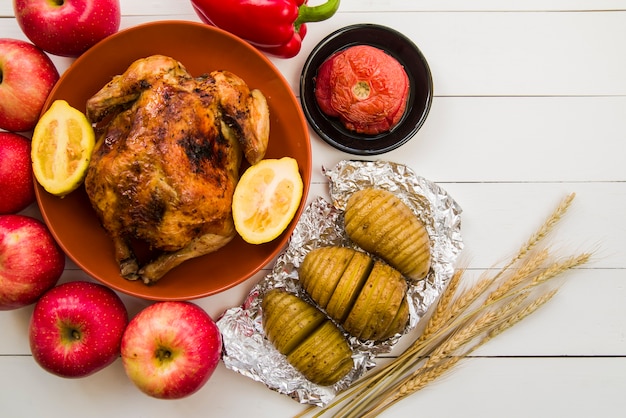Alright, let's talk turkey. Not the political kind, but the kind you roast for a Christmas feast, a thanksgiving dinner, or just because you fancy a good old-fashioned Sunday roast. It's a bit of a challenge, I'll admit. But don't worry, with a bit of know-how, you'll be serving up a succulent bird that'll have everyone singing your praises.
This guide is more than just a recipe, it's my personal take on turkey cooking, peppered with my own experiences, tips, and a touch of humour. Think of it as a chat with a mate over a pint, except we're talking about how to nail that turkey, not the latest football scores.
Part 1: Choosing Your Turkey

Let's start with the star of the show – the turkey itself. Now, you've got options here, and I'm all about giving you the lowdown on what works best.
Fresh or Frozen?
First, you need to decide whether you’re going for fresh or frozen. Fresh is lovely, it’s juicy and tender, but it does need a little more planning as you can’t just pop it in the oven straight from the supermarket. Frozen? No problem, just remember to defrost it properly, which brings me to my next point…
The Art of Defrosting
Defrosting a frozen turkey is like a slow dance – you need to be patient and let it happen at its own pace. Rushing it can lead to uneven thawing and potentially dangerous bacteria growth. So, let's break it down:
Refrigerator Defrosting: This is the safest and most reliable method. It’s slow and steady, allowing the turkey to thaw evenly. A general rule of thumb is to allow one day of thawing for every 4-5 pounds of turkey. So, a 12-pound turkey would need about 2-3 days to fully defrost.
Cold Water Defrosting: This is faster, but it requires a little more attention. Submerge your turkey in a container of cold water, making sure it's completely submerged. Change the water every 30 minutes to ensure the temperature stays consistently cold. This method can take about 4-5 hours for a 12-pound turkey.
Important Note: Never defrost your turkey at room temperature! This is a huge no-no. It creates the perfect environment for bacteria to grow rapidly, which could lead to food poisoning.
Fresh or Frozen: My Verdict
Personally, I prefer fresh turkeys, especially when I'm cooking for a big crowd. It's just that extra bit of effort to get that extra flavour. Plus, if you're lucky enough to have a butcher’s shop near you, you can get them to stuff the bird for you, which is a real game-changer.
Part 2: Prepping Your Turkey

Once you’ve got your turkey, it’s time to get it ready for roasting. This part might seem like a bit of a chore, but trust me, it’s crucial to getting that perfect golden, crispy skin and tender, juicy meat.
The Brine Debate
Now, some people swear by brining their turkey, and I'm one of them. It's a process of soaking the turkey in a salt water solution for a few hours, which helps to keep the meat moist and juicy, and gives it a lovely flavour. But here’s the thing, it’s not for everyone.
The Benefits of Brining
Moisture: The salt in the brine draws moisture out of the meat and then back in, creating a more tender and juicy turkey.
Flavor: Brining also enhances the natural flavour of the turkey, giving it a more robust taste.
Even Cooking: It helps to ensure even cooking, making it less likely that the breast will dry out while the legs are still cooking.
Brining Your Turkey: The Recipe
If you're sold on brining, here's a basic recipe:
In a large bowl or container, mix together 1 cup of salt, 1/2 cup of sugar, and 1 gallon of water.
Add your turkey to the brine, making sure it's completely submerged.
Cover the container and refrigerate for 12-24 hours.
To Brine or Not to Brine: That is the Question
Now, before you go rushing off to make a brine, here's the thing. It's not strictly necessary. A lot of people say they skip it and still get a great turkey. But if you're looking for that extra moistness and flavour, a brine is definitely worth trying.
Stuffing Your Turkey: A Controversial Topic
Stuffing is a classic part of a roast turkey, but it's a bit of a controversial topic. Some people swear by it, while others prefer to cook it separately for safety reasons. It’s up to you, really. I’m a stuffing fan.
Here’s my take:
Stuffing Inside: If you're going to stuff your turkey, make sure you do it just before roasting. Don’t stuff it too tightly, and make sure the stuffing is cooked through.
Stuffing Outside: You can also cook your stuffing separately in a casserole dish, or in small ramekins. This is a safer option, as it allows the stuffing to cook properly.
Part 3: Roasting Your Turkey

The moment we’ve all been waiting for - roasting! Here’s where you need to get your game face on, and trust your instincts.
Getting Started: Setting the Stage
Oven Temperature: Preheat your oven to 325 degrees Fahrenheit (165 degrees Celsius). This temperature is ideal for ensuring even cooking and crispy skin.
Patting the Bird Dry: Pat your turkey dry with paper towels. This will help the skin to crisp up nicely. Removing excess moisture allows the skin to brown properly.
Seasoning: Season your turkey generously with salt, pepper, and any other herbs and spices you like. You can even add a bit of butter or olive oil for extra flavour.
roasting time: The roasting time for a turkey depends on its size. A good rule of thumb is to roast for 15-20 minutes per pound at 325 degrees Fahrenheit. But trust me, those are just guidelines, and you’ve got to check the turkey to make sure it’s done.
How to Check if Your Turkey is Done: The Proof is in the Pudding
The Thermometer Test: This is the most reliable way to tell if your turkey is done. Insert a meat thermometer into the thickest part of the thigh, making sure it doesn't touch any bones. The turkey is done when the thermometer reads 165 degrees Fahrenheit (74 degrees Celsius).
The Jiggle Test: You can also check if the turkey is done by giving the thigh a good jiggle. If the meat feels firm and not jiggly, it's probably cooked through.
Dealing with Dry Turkey: Saving the Day
The worst thing is to overcook your turkey. It can end up dry and flavourless. If you think your turkey might be getting a bit too dry, you can tent it with foil to help it retain moisture. This is a trick I learned from my grandmother, and it works wonders. Just drape a piece of foil loosely over the turkey to create a barrier against the heat.
Part 4: Resting Your Turkey: Patience is a Virtue
It’s tempting to dive into your roasted turkey right away, but it’s important to give it a rest. This allows the juices to redistribute throughout the meat, making it even juicier and more flavourful.
Resting Time: Let It Settle
You need to let your turkey rest for at least 30 minutes before carving. The juices will settle, making it easier to carve and ensuring the turkey stays moist.
Carving Your Turkey: A Skillful Art
Once your turkey has rested, it's time to carve it up. Here’s my advice:
Use a sharp knife: A sharp knife will make carving easier and prevent tearing the meat.
Start with the breasts: Carve the breasts in thin slices, cutting against the grain.
Then move to the legs: Remove the legs and thighs, and then carve them into pieces.
Save the dark meat: The dark meat is more flavorful and juicy, so save it for sandwiches or leftovers.
Part 5: Leftovers: The Best Part
We’re talking roast turkey, so you know there are going to be leftovers. And believe me, these are the best part. There are so many things you can do with your leftover turkey.
turkey sandwiches: A Classic
Who doesn't love a good turkey sandwich?
Try using a toasted crusty bread with a bit of mayonnaise, a slice of tomato, lettuce, and a good dollop of stuffing. You can also add cranberry sauce for a little bit of sweetness.
turkey soup: A Warm and Hearty Comfort
Turn your leftover turkey into a delicious soup.
Simply add chopped turkey, vegetables, and broth to a pot, and simmer until the vegetables are tender. You can use any vegetables you like, such as carrots, celery, potatoes, and onions. A sprinkle of fresh herbs like parsley or thyme adds a beautiful aroma and flavour.
turkey pot pie: A Flaky Delight
Another great way to use up leftover turkey is in a pot pie.
Layer turkey, gravy, and vegetables in a pie dish, and cover with a flaky pastry crust. You can use store-bought pie crust for convenience or whip up your own from scratch.
turkey salad: A Light and Versatile Option
A great option for a lighter lunch, turkey salad is easy to make and very versatile.
Combine chopped turkey, mayonnaise, celery, onion, and seasonings, and serve on bread or crackers. You can add other ingredients like chopped grapes, walnuts, or even a bit of Dijon mustard to add some extra flavour.
Part 6: turkey gravy: The Saucy Star
Gravy is a staple for any roast turkey dinner. It’s that rich, saucy goodness that brings the whole dish together.
Making Gravy: A simple recipe
Here’s a basic gravy recipe:
Ingredients:
Turkey drippings: The essence of flavour from the roasted turkey.
Flour: This acts as a thickener to create the classic gravy texture.
Broth: This adds liquid and depth of flavour to the gravy. You can use chicken broth, turkey broth, or even vegetable broth for a vegetarian option.
Instructions:
Pour the turkey drippings into a saucepan.
Whisk in some flour to create a roux. A roux is a mixture of fat (turkey drippings) and flour. It's the base of most gravy and helps to thicken it. Don't overcook the roux, or it will become bitter.
Slowly whisk in broth until the gravy thickens. Start with a small amount of broth and gradually add more until you reach the desired consistency.
Season to taste. Salt and pepper are essential, but you can also add other spices like garlic powder, onion powder, or herbs like thyme or rosemary.
Tips for Making the Perfect Gravy
Don't overcook the roux: If you cook the flour for too long, it will become bitter.
Whisk constantly: This will prevent lumps from forming. A smooth and silky texture is key to a good gravy.
Use good-quality broth: A good broth will make a big difference in the flavour of your gravy.
Part 7: Accompaniments: Completing the Feast
No roast turkey feast is complete without some tasty accompaniments. Here are some of my favourites:
Stuffing: A Classic Companion
Stuffing is a must-have for any roast turkey dinner. It’s a classic side dish that everyone loves.
You can make stuffing with bread, herbs, vegetables, and spices. The options are endless!
mashed potatoes: Comforting and Creamy
Mashed potatoes are a comforting and delicious side dish that goes perfectly with roast turkey.
You can add butter, milk, sour cream, or even cheese for extra flavour and richness.
Roasted Vegetables: A Healthy and Flavorful Side
Roasted vegetables are a healthy and delicious way to add some colour and flavour to your plate.
Try roasting root vegetables like carrots, potatoes, and parsnips, or opt for seasonal vegetables like Brussels sprouts, asparagus, or green beans.
Cranberry Sauce: Sweet and Tart
Cranberry sauce is a sweet and tart condiment that adds a nice contrast to the savoury turkey.
You can make cranberry sauce from scratch or use store-bought cranberry sauce. If you're feeling ambitious, try adding orange zest or a splash of brandy for a unique flavour.
green bean casserole: A Thanksgiving Tradition
A classic Thanksgiving dish, green bean casserole is a creamy and comforting side dish.
It's made with green beans, mushrooms, onions, and a creamy sauce. You can use canned cream of mushroom soup or make your own sauce for a homemade touch.
Part 8: Serving Your Turkey Feast: The Grand Finale
You’ve done all the prep, you’ve roasted your turkey to perfection, and now it’s time to show off your culinary skills.
Plating and Presentation: Making it Look as Good as It Tastes
A bit of presentation goes a long way. Don’t be afraid to put some effort into the way you plate your turkey and sides.
Choose the right serving dishes: Use attractive serving dishes that are large enough to hold all the food. Think about the colours and textures of the dishes and how they will complement the food.
Arrange the food attractively: Don’t just pile everything on a plate. Arrange the food in a visually appealing way. Consider creating a centrepiece with the turkey, surrounded by the side dishes.
Add some garnishes: A few sprigs of rosemary or thyme can add a touch of elegance to your table. Fresh herbs not only look beautiful but also add a touch of aroma to the meal.
The Feast: Time to Enjoy!
It’s time to eat! Be sure to set a relaxed and festive atmosphere to enjoy your hard work. Put on some music, light some candles, and gather your loved ones around the table. This is the moment you've been working towards, so relax and enjoy the fruits of your labour.
Part 9: FAQs: Answering Your Questions
Here are some frequently asked questions about turkey cooking:
1. How do I tell if my turkey is cooked?
The best way to tell if your turkey is cooked is to use a meat thermometer. The turkey is done when the internal temperature reaches 165 degrees Fahrenheit (74 degrees Celsius) in the thickest part of the thigh.
Don’t rely solely on the visual appearance of the turkey, as it can be misleading. A meat thermometer is the only way to ensure that the turkey is cooked through and safe to eat.
2. How long should I roast my turkey?
The roasting time for a turkey depends on its size. A good rule of thumb is to roast for 15-20 minutes per pound at 325 degrees Fahrenheit.
However, always use a meat thermometer to confirm that the turkey is cooked through to the correct internal temperature.
3. What should I do with leftover turkey?
There are endless possibilities with leftover turkey! Make sandwiches, soup, pot pie, salad, or even use it in a stir-fry.
Get creative and experiment with different flavour combinations!
4. How do I make gravy?
To make gravy, simply whisk together turkey drippings, flour, and broth in a saucepan.
Start with a small amount of broth and gradually add more until you reach the desired consistency. Be sure to whisk constantly to prevent lumps.
5. What are some good accompaniments for turkey?
Some classic accompaniments for turkey include stuffing, mashed potatoes, roasted vegetables, cranberry sauce, and green bean casserole.
These sides complement the turkey beautifully and create a balanced and flavourful meal.
Now, go forth and conquer the turkey! With a little planning, some patience, and this guide, you’ll be serving up a delicious and impressive feast that will have everyone impressed.
Everyone is watching

How to Cook Frozen Lobster Tails Perfectly: A Step-by-Step Guide
RecipesLobster. Just the word conjures up images of lavish meals, special occasions, and a taste of luxury. But let's...

Pork Fillet Cooking Time: How Long to Cook It Perfectly
RecipesPork fillet, or tenderloin as it's sometimes called, is a real favourite in our house. It's so versatile, and...

Pigs in a Blanket Cooking Time: How Long to Bake for Perfect Results
RecipesAh, pigs in a blanket. Just the name conjures up images of those delightful little parcels of crispy pastry en...

The Ultimate Guide to Cooking Delicious Frankfurters
RecipesLet's face it, we all love a good frankfurter. It's a classic, simple, and always satisfying. But let's be rea...

Wolf Meat Recipes: A Guide to Cooking Wild Game
RecipesLet's be honest, you don't see wolf meat at your local butcher shop every day. It's a bit of a wild card, but ...
